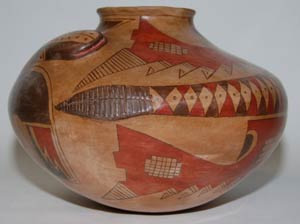Mexican Potter's Vision Puts Mata Ortiz on the Map
 Associated Press Associated Press
go to original


| | Mata Ortiz pottery. (R.G. Munn Auctions & LiveAuctioneers.com) | | |
Sierra Vista, Ariz. - In about 1955, a teenage Mexican boy named Juan Quezada found a cave near the village of Mata Ortiz, Chihuahua in Mexico, containing some ceramic pots created by the ancient Paquime Indians.

He started to experiment with locally available materials to try to re-create the pottery. In 1971, after about 16 years of work, he figured out how to do it. He later taught the skill to his extended family members.

Gradually, more people learned, and today there are hundreds of artists in Mata Ortiz, located about four hours by car southeast of Bisbee, Ariz., who make exquisite handmade pottery appreciated by collectors worldwide.

In January 1976, an American named Spencer MacCallum went to a secondhand shop in New Mexico and saw some pottery for sale. He was fascinated by its quality.

The pieces were not signed. MacCallum wondered where they came from, and, more importantly, who made them. So, he traveled in search of the potter in March of that year. He showed people photos of the pottery and was directed to Quezada in Mata Ortiz.

"I did not take the pots, for fear Customs might think they were old and confiscate them," MacCallum said. "When I found Juan, he couldn't believe anyone would take pictures of his pots, much less come down looking for them."

MacCallum saw great potential in the pottery. He wanted Quezada to practice, so he offered to pay him a monthly stipend to do so.

MacCallum began displaying items in museums in the United States. He and Quezada traveled across the country for exhibitions, as well as demonstrations.

All the materials and supplies needed to produce Mata Ortiz pottery are collected from the valley and mountain terrain near Mata Ortiz, said Roberto Banuelos, 47, who has made pottery for about 23 years.

The process starts with collecting different types of clay, including yellow, red, black and white, which are mixed to make certain colors, he said.

The pots are built by hand without the use of a potter's wheel. Each artist has a unique style. The pottery is decorated with animals or other designs, many inspired by the prehistoric ceramic art.

The paints are made from local minerals and an addition of a little clay. The paint brushes are natural as well, he added. The bristles are made from human hair. Banuelos said one brush consists of about six strands of his own hair.

Finally, the pottery is heated to harden it. Fuel for the fire is dried cattle manure.

In the early 1970s, Quezada taught his siblings how to make the pottery. But it was not until around 1983 or 1984 that significant numbers of people became interested in learning so they could earn money selling the art, according to MacCallum.

Quezada, now 68, said he decided to share his skills with other people in Mata Ortiz, including family and friends, because he thought it was the right thing to do.

"I was eating well and I was dressed well," he said. "I didn't want to be living well while the others were not."

Now, many families in Mata Ortiz and the surrounding area benefit greatly as a result of Quezada's ingenuity and generosity.

Demand for the products stays high, as tourists travel long distances to visit Mata Ortiz and purchase pieces. The pottery is also available through the Internet and at specialty auctions.

Prices in the village depend on the size and the quality of the work. A small piece by an inexperienced artist could sell for as little as $10, while a large one by master potter Quezada could cost as much as $4,000 or even more.

Walter Parks wrote a book called The Miracle of Mata Ortiz that was published in 1993. MacCallum, now 76, thought the title was an overstatement at the time, but now he believes the word "miracle" is appropriate.

"In the beginning I knew there was one individual who was potentially a world-level artist. I just had that intuitive sense. But I had no inkling it would come to involve an entire village," he said.

MacCallum, who lives in nearby Casas Grandes, Chihuahua, said he is pleased to see the people of Mata Ortiz are now so comfortable as peers with Americans.

"So many people now come down first for the pottery and by the third trip they are coming down to visit with their friends - real friends - that they have made in Mata Ortiz," MacCallum said.

"That is one of the most gratifying things about all of this."

Information from: Sierra Vista Herald, http://www.svherald.com |



